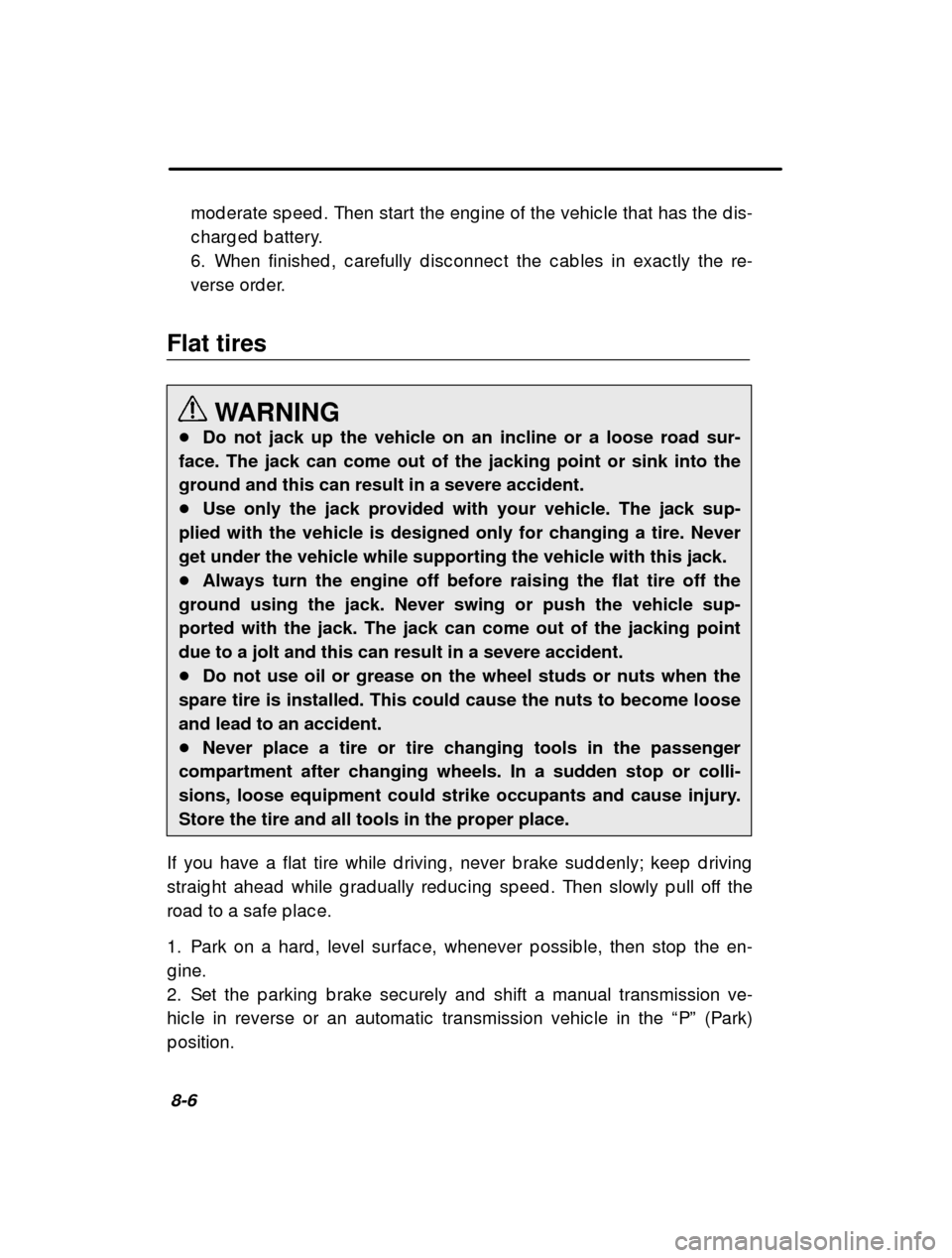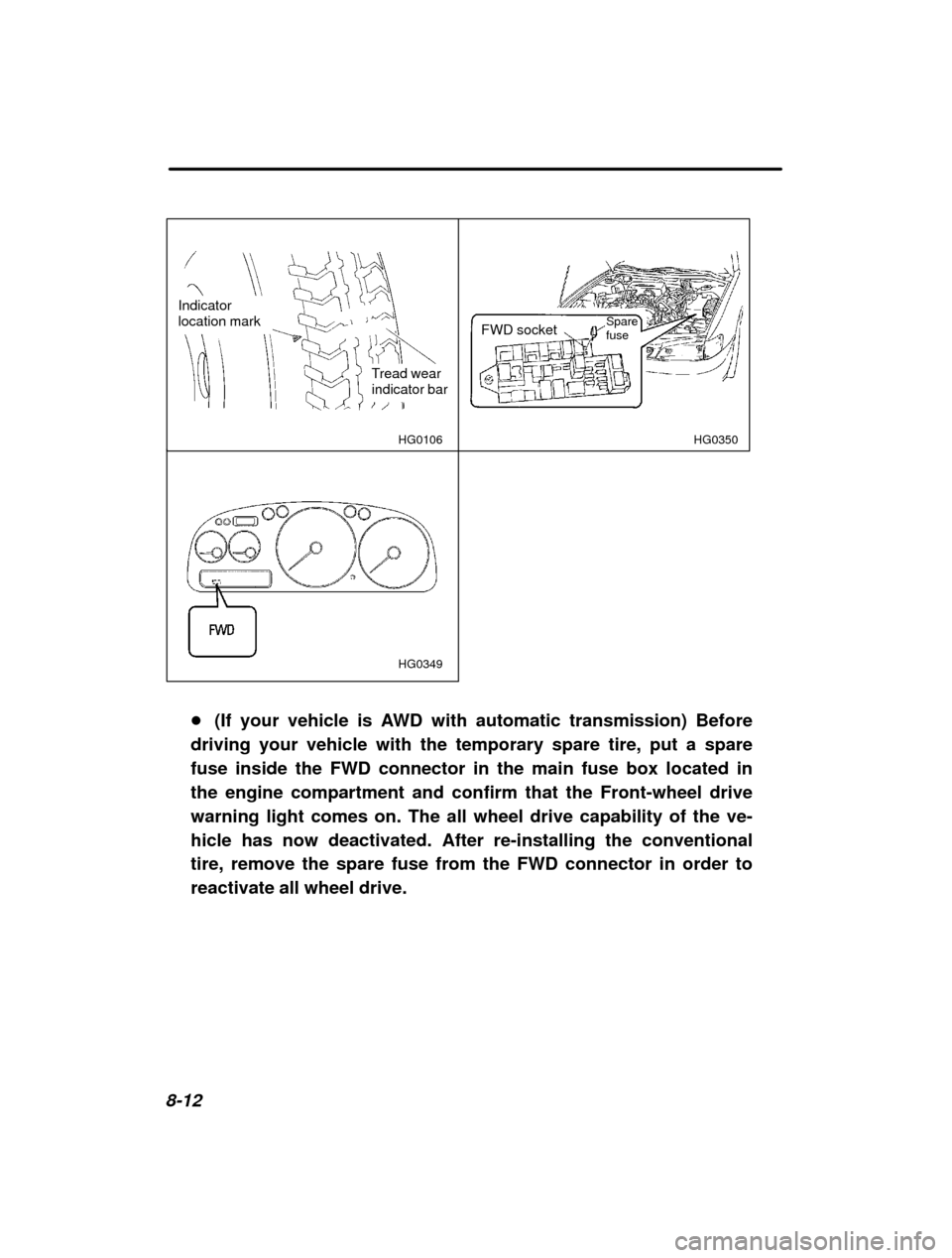2000 SUBARU IMPREZA automatic transmission
[x] Cancel search: automatic transmissionPage 216 of 320

7-46Driving on snowy g rad es or ic y road s may req uire th
e use of tire c hains,
in whic h c ase p ut the c hains on the front wheels on ly. Use only SAE
c lass S typ e c hains that are of the c orrec t size fo r your tires so as not to
d amag e the vehic le b od y or susp ension.
When d riving with tire c hains, d rive at sp eed s b elo w 19 mp h (30 km/h).
When a temp orary sp are tire is on a front wheel, re p lac e the temp orary
sp are tire with the rear tire on the same sid e of t he vehic le, and then fit
c hains on the front tires.
Always use the utmost c are when d riving with tire c hains — overc onfi-
d enc e b ec ause you are d riving with tire c hains c oul d easily lead to a se-
rious ac c id ent.
� Rocking the vehicle
If you must roc k the vehic le to free it from snow, sand , or mud , d ep ress
the ac c elerator p ed al slig htly and move the selec to r lever b ac k and forth
b etween “D ” and “R ” rep eated ly. Do not rac e the eng ine. For the b est
p ossib le trac tion, avoid sp inning the wheels when t rying to free the ve-
hic le.
When the road surfac e is extremely slip p ery, you c a n ob tain b etter trac -
tion b y starting the vehic le with the transmission in 2nd than 1st (b oth for
MT and AT).
Refer to the “Automatic transmission ” sec tion in this c hap ter for informa-
tion on hold ing the transmission in 2nd p osition.
� Corrosion protection
Refer to the “Corrosion p rotec tion ” sec tion (c hap ter 9).
Page 224 of 320

7-54c lutc h at mod erate eng ine rp m.
Avoid uneven steering , sharp turns and rap id lane c
hang es.
Slow d own b efore turning . Make a long er than normal turning rad ius
b ec ause the trailer wheels will b e c loser than the vehic le wheels to
the insid e of the turn. In a tig ht turn, the traile r c ould hit your vehic le.
Crosswind s will ad versely affec t the hand ling of yo ur vehic le and trail-
er, c ausing sway. Crosswind s c an b e d ue to weather c ond itions or the
p assing of larg e truc ks or b uses. If swaying oc c urs , firmly g rip the
steering wheel and immed iately slow d own g rad ually.
When p assing other vehic les, c onsid erab le d istanc e is req uired b e-
c ause of the ad d ed weig ht and leng th c aused b y atta c hing a trailer to
your vehic le.
Before g oing d own a steep hill, slow d own and shift into low g ear in
ord er to utilize the eng ine b raking effec t and p rev ent overheating of
your vehic le ’s b rakes. Do not make sud d en d ownshifts.
When g oing up hill on hot d ays, turn off your air c o nd itioner to red uc e
the p ossib ility of eng ine overheating c aused b y the ad d ed load of the
trailer.
Pay attention to your water temp erature g aug e.
If your vehic le has an automatic transmission, avoi d using the ac c el-
erator p ed al to stay stationary on an up hill slop e instead of using the
p arking b rake or foot b rake. This may c ause the tra nsmission fluid to
overheat.
Always b loc k the wheels und er b oth vehic le and trai ler when p arking .
Ap p ly the p arking b rake firmly. You should not p ark on a hill or slop e.
But if p arking on a hill or slop e c annot b e avoid ed , you should take
the following step s:
1. Ap p ly the b rakes and hold the p ed al d own.
2. Have someone p lac e wheel b loc ks und er b oth the ve hic le and
trailer wheels.
3. When the wheel b loc ks are in p lac e, release the r eg ular b rakes
slowly until the b loc ks ab sorb the load .
Page 231 of 320

8-6mod erate sp eed . Then start the eng ine of the vehic l
e that has the d is-
c harg ed b attery.
6. When finished , c arefully d isc onnec t the c ab les in exac tly the re-
verse ord er.
Flat tires
WARNING
� Do not jack up the vehicle on an incline or a loose road sur-
face. The jack can come out of the jacking point or sink into theground and this can result in a severe accident.� Use only the jack provided with your vehicle. The jack sup-
plied with the vehicle is designed only for changing a tire. Neverget under the vehicle while supporting the vehicle with this jack.� Always turn the engine off before raising the flat tire off the
ground using the jack. Never swing or push the vehicle sup-ported with the jack. The jack can come out of the jacking pointdue to a jolt and this can result in a severe accident.� Do not use oil or grease on the wheel studs or nuts when the
spare tire is installed. This could cause the nuts to become looseand lead to an accident.� Never place a tire or tire changing tools in the passenger
compartment after changing wheels. In a sudden stop or colli-
sions, loose equipment could strike occupants and cause injury.Store the tire and all tools in the proper place.
If you have a flat tire while d riving , never b rake sud d enly; keep d riving
straig ht ahead while g rad ually red uc ing sp eed . Then slowly p ull off the
road to a safe p lac e.
1. Park on a hard , level surfac e, whenever p ossib le, then stop the en-
g ine.
2. Set the p arking b rake sec urely and shift a manual transmission ve-
hic le in reverse or an automatic transmission vehic le in the “P ” (Park)
p osition.
Page 237 of 320

8-12
HG0350
Indicator location mark
Tread wear indicator barHG0106
HG0349
FWD socket Spare fuse
� (If your vehicle is AWD with automatic transmission) Before
driving your vehicle with the temporary spare tire, put a spare fuse inside the FWD connector in the main fuse box located inthe engine compartment and confirm that the Front-wheel drivewarning light comes on. The all wheel drive capability of the ve-
hicle has now deactivated. After re-installing the conventionaltire, remove the spare fuse from the FWD connector in order to
reactivate all wheel drive.
Page 239 of 320

8-14Towing
If towing is nec essary, it is b est d one b y your SUB
ARU d ealer or a c om-
merc ial towing servic e. Ob serve the following p roc e d ures for safety.
� Transporting your vehicle using a flat-bed truck
HG0108
This is the b est way to transp ort your vehic le. Use the following p roc e-
d ures to ensure safe transp ortation.
1. Shift the selec tor lever into the “P ” p osition for automatic transmis-
sion vehic les or “1st ” for manual transmission vehic les.
2. Pull up the p arking b rake lever firmly.
3. Sec ure the vehic le onto the c arrier p rop erly with safety c hains.
Eac h safety c hain should b e eq ually tig htened and c are must b e
taken not to p ull the c hains so tig htly that the su sp ension b ottoms out.
� Towing with the front wheels raised off the ground
WARNING
Never tow manual transmission AWD vehicles with the front wheels raised off the ground while the rear wheels are on theground. This will cause the vehicle to spin away due to the opera-tion or deterioration of the viscous coupling.
Page 241 of 320

8-16CAUTION
� If transmission failure occurs, transport your vehicle on a flat-
bed truck. � For AWD vehicles or FWD vehicles with automatic transmis-
sion, the traveling speed must be limited to less than 20 mph (30km/h) and the traveling distance to less than 31 miles (50 km). Forgreater speeds and distances, transport your vehicle on a flat-bed truck.� For OUTBACK models, be sure to use a flexible cable for tow-
ing purpose and wrap the towing cable with cloth to prevent dam-
age to the bumper.
OM-H0180
We d o not rec ommend this method of towing . Use this method only
when towing servic e b y a SUBARU d ealer or a c ommerc ial towing
servic e is not availab le.
1. Chec k the transmission and d ifferential oil level s and ad d oil to
b ring it to the up p er level if nec essary.
2. Release the p arking b rake and p ut the transmissio n in neutral.
3. The ig nition switc h should b e in the “ACC ” p osition while the ve-
hic le is b eing towed .
4. Take up slac k in the towline slowly to p revent d a mag e to the ve-
hic le.
Page 249 of 320

10
Maintenance and service
Maintenance schedule 10-3
. . . . . . . . . . . . . . . . . . . . . . . . . . . . . . . . . . . . . . . . . . . . . . . . . .
Maintenance precautions 10-3
. . . . . . . . . . . . . . . . . . . . . . . . . . . . . . . . . . . . . . . . . . . . . .
Engine compartment overview 10-6 . . . . . . . . . . . . . . . . . . . . . . . . . . . . . . . . . . . . . . .
Engine oil 10-7
. . . . . . . . . . . . . . . . . . . . . . . . . . . . . . . . . . . . . . . . . . . . . . . . . . . . . . . . . . . . . . . . . . . .
Cooling system 10-12
. . . . . . . . . . . . . . . . . . . . . . . . . . . . . . . . . . . . . . . . . . . . . . . . . . . . . . . . . . . .
Engine coolant 10-13
. . . . . . . . . . . . . . . . . . . . . . . . . . . . . . . . . . . . . . . . . . . . . . . . . . . . . . . . . . .
Air cleaner element 10-16
. . . . . . . . . . . . . . . . . . . . . . . . . . . . . . . . . . . . . . . . . . . . . . . . . . . . . .
Spark plugs 10-17
. . . . . . . . . . . . . . . . . . . . . . . . . . . . . . . . . . . . . . . . . . . . . . . . . . . . . . . . . . . . . . . . .
Drive belts 10-18
. . . . . . . . . . . . . . . . . . . . . . . . . . . . . . . . . . . . . . . . . . . . . . . . . . . . . . . . . . . . . . . . . . .
Manual transmission oil 10-19
. . . . . . . . . . . . . . . . . . . . . . . . . . . . . . . . . . . . . . . . . . . . . . . .
Automatic transmission fluid 10-20 . . . . . . . . . . . . . . . . . . . . . . . . . . . . . . . . . . . . . . . . .
Front differential gear oil (Automatic transmission vehicles) 10-22 . . . . . . . . . . . . . . . . . . . . . . . . . . . . . . . . . . . . . . . . . . . . . . . . . . . . . . . . . . . . . . . . . .
Rear differential gear oil 10-23
. . . . . . . . . . . . . . . . . . . . . . . . . . . . . . . . . . . . . . . . . . . . . . . .
Power steering fluid 10-25
. . . . . . . . . . . . . . . . . . . . . . . . . . . . . . . . . . . . . . . . . . . . . . . . . . . . .
Brake fluid 10-26
. . . . . . . . . . . . . . . . . . . . . . . . . . . . . . . . . . . . . . . . . . . . . . . . . . . . . . . . . . . . . . . . . . .
Clutch fluid (2.5 liter MT models) 10-28 . . . . . . . . . . . . . . . . . . . . . . . . . . . . . . . . . . . .
Brake booster 10-29
. . . . . . . . . . . . . . . . . . . . . . . . . . . . . . . . . . . . . . . . . . . . . . . . . . . . . . . . . . . . . .
Battery 10-29
. . . . . . . . . . . . . . . . . . . . . . . . . . . . . . . . . . . . . . . . . . . . . . . . . . . . . . . . . . . . . . . . . . . . . . . .
Windshield washer fluid 10-31
. . . . . . . . . . . . . . . . . . . . . . . . . . . . . . . . . . . . . . . . . . . . . . . .
Replacement of windshield wiper blades 10-32 . . . . . . . . . . . . . . . . . . . . . . . .
Brake pedal 10-34
. . . . . . . . . . . . . . . . . . . . . . . . . . . . . . . . . . . . . . . . . . . . . . . . . . . . . . . . . . . . . . . . .
Clutch pedal (Manual transmission vehicles) 10-36 . . . . . . . . . . . . . . . . . . .
Replacement of brake pad and lining 10-37 . . . . . . . . . . . . . . . . . . . . . . . . . . . . . .
Parking brake stroke 10-38
. . . . . . . . . . . . . . . . . . . . . . . . . . . . . . . . . . . . . . . . . . . . . . . . . . . .
Tires and wheels 10-39
. . . . . . . . . . . . . . . . . . . . . . . . . . . . . . . . . . . . . . . . . . . . . . . . . . . . . . . . . .
Tire pressure 10-39
. . . . . . . . . . . . . . . . . . . . . . . . . . . . . . . . . . . . . . . . . . . . . . . . . . . . . . . . . . . . .
Tire rotation 10-40
. . . . . . . . . . . . . . . . . . . . . . . . . . . . . . . . . . . . . . . . . . . . . . . . . . . . . . . . . . . . . . .
Aluminum wheels (if equipped) 10-44 . . . . . . . . . . . . . . . . . . . . . . . . . . . . . . . . . . . . . .
Fuses 10-44
. . . . . . . . . . . . . . . . . . . . . . . . . . . . . . . . . . . . . . . . . . . . . . . . . . . . . . . . . . . . . . . . . . . . . . . . .
Main fuse and fusible link 10-47 . . . . . . . . . . . . . . . . . . . . . . . . . . . . . . . . . . . . . . . . . . . . . .
Installation of accessories 10-48 . . . . . . . . . . . . . . . . . . . . . . . . . . . . . . . . . . . . . . . . . . . . .
Replacing bulbs 10-49
. . . . . . . . . . . . . . . . . . . . . . . . . . . . . . . . . . . . . . . . . . . . . . . . . . . . . . . . . . .
Headlight 10-49
. . . . . . . . . . . . . . . . . . . . . . . . . . . . . . . . . . . . . . . . . . . . . . . . . . . . . . . . . . . . . . . . . .
Page 254 of 320

10-6Engine compartment overview
1 Manual transmission oil level
g aug e (MT) (p ag e 10-19) or
Differential g ear oil level
g aug e (AT) (p ag e 10-22)
2 Air c leaner element
(p ag e 10-16)
3 Clutc h fluid reservoir
(p ag e 10-28)
4 Automatic transmission fluid
level g aug e (p ag e 10-20)
5 Brake fluid reservoir
(p ag e 10-26)
6 Fuel filter 7
Wind shield washer tank
(p ag e 10-31)
8 Fuse b ox (p ag e 10-44)
9 Battery (p ag e 10-29)
Q Eng ine oil filler c ap
(p ag e 10-7)
W Eng ine c oolant reservoir
(p ag e 10-13)
E Eng ine oil level g aug e
(p ag e 10-7)
R Power steering fluid reservoir
(p ag e 10-25)
T Rad iator c ap (p ag e 10-13) HGA017BB